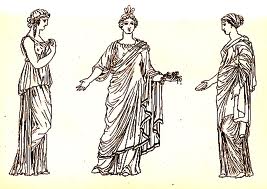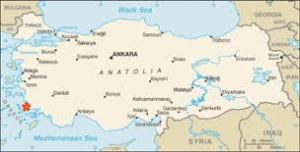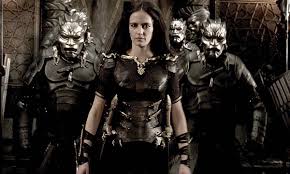A couple weeks ago, I took a look at 300 2: Rise of an Empire (2014, dir. Noam Murro). That post was mainly focused on the overall plot and the military details of the film, so I didn’t get much chance to talk about the main bad guy, Artemisia (Eva Green). So today, I’m going to look at this intriguing historical figure and consider how the film portrays her.
Spoiler Alert and Trigger Warning: If you plan on seeing this film in the theater, you may wish to do so before you read this post, since I talk about major plot points, including the film’s conclusion. Also, this post discusses rape.
Oh, and let me get one issue out of the way right at the start. The cinematic Artemisia gets to wear lots of awesome sexy clothes that cling to her body and look absolutely nothing like anything any ancient Greek woman ever wore. During the Greek Archaic period, Greek women, even queens, were expected to cover most of their body in a tubular dress known as a peplos. It rose up from the ankles, was pinned at the shoulders, and then folded back down to just past the waist, where it was usually belted. It was a loose dress that covered the body but left the face and the arms bare. Alternately, she could wear a chiton, a dress that was sewn more than pinned. This usually had half-sleeves. Over this garment was often worn a type of cloak called a himation.
Women, or at least elite women, generally wore their hair up in a hairnet. Braids, pins, tiaras, and veils or other wraps were also common. Lacking straight-irons, they rarely just let their hair hang down.
So in public, Artemisia probably looked like this:
and not like this:
In fact, when a relative died, Greek women enacted mourning by pulling the decorations out of their hair and ripping their clothes. So, to the extent that the outfit in the above shot of Artemisia would have signified anything to the ancient Greeks, they probably would have read it as mourning garb. So maybe Artemisia is an early version of a Goth chick.
As a rule of thumb, remember that Hollywood generally dresses women in clothing and hairstyles that reflect contemporary fashions rather than historical ones. In movies that are more interested in historical accuracy, the clothing might make an attempt at accuracy, but the hairstyles almost never do (although The Advocate is something of an exception to this principle.)
The Historical Artemisia
Artemisia ruled Caria, in the southwestern corner of modern Turkey, from its capital of Halicarnassus (modern Bodrum). In 545, a couple generations before, Caria was incorporated into the Achaemenid (Persian) Empire, as one of its satrapies (essentially a province with semi-independent government). So in keeping with Achaemenid practices, Caria was a kingdom administered by a monarch on behalf of the Persian shahanshan (literally, ‘the king of kings’, or emperor).
As is often the case with ancient history, a lot of Artemesia’s life is lost to us. Her father was king of Caria, and so she seems to have inherited the office for him, although her husband was the actual ruler down until his death. When he died, he left behind a young son, so Artemisia acted as the regent for her son. We don’t have clear dates for these events; we only know that she was ruling by 480 BC.
When Xerxes went to war against the Greek city-states, Artemisia contributed five ships and acted as their commander. Most of what we know about her participation in this war derives from the pages of Herodotus, who is known for including a lot of wild stories in his History. Thus, we have to take what he tells us with a grain of salt.
According to Herodotus, before the battle of Salamis, Xerxes gathered all his generals, including Artemisia, and asked if he should commit to a naval battle (since his navy’s main purpose was to provide supplies for his massive army, which was too large to live off the land). All his generals, apparently being yes-men, agreed that he should, but Artemisia pointed out that the Greeks were better seamen than the Persians. She also argued that Xerxes had already conquered Athens and that the other city-states could not hold out very long individually. In other words, Xerxes was already winning on land and didn’t need a naval victory. Xerxes reportedly praised her advice, but then ignored it and decided to engage the Athenian navy at what became the battle of Salamis.
Salamis, of course, turned out to be a trap, and Themistokles crushed Xerxes’ navy. When Artemisia realized that the Persians were losing, she tried to retreat, but was unable to do so because there were other Persian ships in the way, and a Greek trireme was bearing down on her. To fool the Greek ship, she ordered her ship to ram another Persian ship. This made an opening for her, and it tricked the Greek trireme into assuming she was on their side. As a result, she was able to get away in good order. This story of Artemisia ramming the Persian ship was rather famous; it’s reported in several other sources. Two sources claim that when Xerxes saw the ramming, without realize that she was hitting a Persian ship, he remarked that his men had become women and his women had become men.
After the defeat at Salamis, Herodotus tells us that Xerxes again asked her for advice. He wanted to know if he should lead his army into the Peloponnesus personally, or withdraw to Persia and allow his general Mardonus to handle the campaign. She advised him to withdraw, because if Mardonus won, the glory would still go to Xerxes, while if he lost, Xerxes would not be at risk. Xerxes listened to her and withdrew to Persia.
Herodotus bookends his description of Salamis with these two scenes of Xerxes getting advice from Artemisia. The first time Xerxes ignores the advice and regrets it, while the second time he listens and benefits (since Mardonus was disastrously defeated later in the campaign). This symmetry makes Herodotus’ story a little suspect, and that calls attention to some of the inconsistencies in the account. If Xerxes liked Artemisia’s advice well enough to praise it, why did he ignore it? If he really didn’t know his navy well enough to know that Artemisia had attacked his ship, how did he know it well enough to know that she was commanding the ship? Also, since Greeks generally considered women inferior to men, this story has the unstated point that Xerxes is a fool, because he needs a woman to tell him how to make good choices. So this story, while famous, is a little suspect.
These stories all emphasize that Artemisia survived the battle of Salamis, but that’s pretty much the last solid information we have about her. Presumably she returned home at some point, but we do not know what became of her, how long she ruled, or when she died. Her grandson was king of Halicarnassus when Herodotus spent time there, so perhaps his stories are essentially family legends about Artemisia.
The Cinematic Artemisia
The movie’s version of Artemisia is quite a different creature than the historical Artemisia; in fact, about the only similarities are her name and the fact that she’s associated with ships. She’s not a queen; rather she’s the daughter of an average family whose city is sacked. Her family is killed and she is enslaved and raped repeatedly before being discarded as a teenager (a rather odd point, since teenagers were ideal slaves in many regards, with years of service ahead of them and breeding potential if the master wanted it). One of Xerxes’ men (Peter Mensah) finds her and trains her to become a ruthless warrior who murders her way to the top of the Persian political and military hierarchy; she becomes the most trusted general of first Darius and then Xerxes. In fact, in contrast to Xerxes’ depiction in the first film, in this film, Artemisia is virtually his puppet-master, pulling his strings and at one point flat-out insulting him and defying him.
There are a couple of notable things about this version of her story. First, it falls into a trend in contemporary film of having strong female characters. In contrast, for example, to most female leads of, say, 80s or 90s action films, Artemisia is not a defenseless maiden who needs rescuing by the hero, nor is she a femme fatale who needs to manipulate men to get her way. She has a great deal of agency, is a forceful personality, and is fully capable of both leading troops and fighting in person. In that sense, she’s fun to watch, even if the idea of female warriors in ancient Greece is complete fiction.
However, she’s also an example of another trend in recent film and television, the trend to equate strong women with women who have been raped. In the past year or two, the ‘raped strong woman’ trope has become so common in film and tv that it’s attracted a fair amount of commentary, and may be in danger of becoming just another cliché. Rape is certainly an important issue, and it can be argued that it is healthy for entertainment to expose viewers to this ugly problem. But it’s unfortunate that Hollywood seems to have become fixated on the idea that rape can somehow explain why a woman is strong, as if a woman cannot be strong without having been raped. Putting a rape in a woman’s back story can serve to make her a more complex character, but it can also become a lazy and brutal crutch for scriptwriters who can’t imagine more nuanced ways to develop a female character; surely there are more stories to tell about women than just this one. There’s a fine line between acknowledging an all-too-common problem for women (especially for women who are victims of war) and using rape as a cheap way to add some ‘grittiness’ to a story while suggesting that rape is simply a universal fact of life and therefore nothing to be shocked by.
Another problem with the film is that it completely ignores the one probably genuine story we have about Artemisia. Her escape from Salamis demonstrates that Artemisia was a cunning and ruthless woman, and it would have fit perfectly well into her character as the film presented it. But instead, the screenwriters dropped the real story and just made up nonsense about an iron oil-tanker and guards sent on suicide missions with exploding backpacks (which is how this film got its obligatory Stuff Blows Up scene). It demonstrates that the screenwriters weren’t in the least bit interested in the actual history, and really just wanted to make up cool stuff for the fan-boys, even when that cool stuff makes no sense whatsoever. At least the first 300 tried to get the basic narrative facts right even as it was getting everything else wrong.
A third problem with her character is the way her sexuality is handled. This mostly gets explored in the two encounters Artemisia has with Themistokles (Sullivan Stapleton). The first real meeting happens about half way through the film, when Themistokles is taken by boat to meet with Artemisia. Historically, Themistokles sent Xerxes’s fleet a message that he wished to defect, and this was how he lured the Persians into the trap at Salamis. When Themistokles went to meet Artemisia, I initially thought that this would be the film’s way of handling this detail; certainly replacing a message with a face-to-face meeting would be a reasonable bit of dramatic liberty.
Unfortunately, the scene’s actual purpose is just to give our two main characters a chance to have some sexytime. We get to see the actors mostly naked having rough sex. The whole scene is essentially pointless, except from the standpoint of satisfying the audience’s voyeuristic urges. (And, as an aside, why doesn’t Artemisia try to kill Themistokles in this scene? Why does she let him sail back to his fleet? She’s evil, and not even remotely honorable, so logically she wouldn’t scruple to not kill him if she has the chance. Crappy plotting, if you ask me.) The scene doesn’t advance the plot at all, nor is Themistokles’ offer to betray the Greek fleet even mentioned in the film. The scene does mean that when the two of them meet up again at the end of the film, the whole scene feels very Freudian, so that when Themistokles stabs her with his sword, he’s essentially killing her with his penis.
If we put all of these made-up details together, the whole narrative arc takes on a rather ugly overtone. Artemisia’s ‘strength’ is basically driven by the fact of her rape, which provides literally the only motive she seems to have in the film, namely to punish all men for what has happened to her. Her murders of various Persian leaders and her manipulation and defiance of Xerxes demonstrate that she is a destructive force that turns the world upside-down, overturning male authority and destabilizing her society (she’s actually the one who kills Darius). Her enjoyment of rough sex becomes a symptom of her rape. And her death at the end of Themistokles’ penis-sword becomes a symbolic re-assertion of the proper order of society, an order grounded on male sexual domination of women. While Artemisia has agency, she has no clear motives or desires; her villainy is not due to personal ambition or some twisted moral cause, but simply a clichéd hatred of men, and her defeat at the end is not due to a specific mistake or character flaw, but rather to the fact that she is incapable of dominating Themistokles for the simple reason that he refuses to live as a slave.
If the first 300 is a story about how straight white men overcome the ugly, sexually deviant non-whites of the world, 300 2 is a story about how straight men overcome the threat posed by an uncontrollable woman. In both cases the enemy represents servitude and the heterosexual male hero represents liberty.
While rape can, in the right hands, be a powerful device for telling a story about women’s experiences, in this case, the rape is just cheap, lazy storytelling that serves to demonize its female character. This script victimizes Artemisia twice, once when it makes her the victim of rape, and once when it replaces what was apparently a strong, clever real historical women with a cheap male fantasy of a dangerous woman who needs to be defeated to preserve male sexual authority.
Want to Know More?
300: Rise of an Empireis available on Amazon.
Our best source for the Persian Wars and for Artemisia is Herodotus’ The Histories, Revised (Penguin Classics).There’s also a version, Herodotus: The Persian War (Translations from Greek and Roman Authors), that’s only the sections about the Persian Wars with scholarly explanations added.










Though that “hate-sex” scene was a bit much, Artemesia was by far the best part of the 300 sequel. Eva Green was weird, so serious and good as her, that I didn’t care about how dumb the rest of the movie. Nice post!
LikeLike
I totally agree that Green was the best part of the film. It’s a pity it wasn’t a better part for her.
LikeLike
I think one of the major problems with adapting 300 the comic, and also 302: The Legend of Xerxes’ Gold is that they’re adapted from Frank Miller material, and Frank Miller is actually an insane, deeply misogynist fascist.
I can really imagine guys like Zach Snyder and whoever wrote and directed this kind of imagining that they were working towards a narrative about freedom and liberty and some such, but when you start with material that’s poisonously fascist, you can never really get away from it.
LikeLike
I would agree. But I think it’s important to acknowledge that Snyder and Murro and their crews were making choices to follow Miller’s material. They could easily have introduced changes if they had cared to. Ultimately, they and not Miller are responsible for what they put onto the screen.
LikeLike
I don’t disagree, I guess I just kind of feel a little bad for Zach Snyder. The impression that I always get from him in interviews, and from his other movies, is that he is genuinely interested in making thoughtful movies and has a fairly progressive attitude towards the topics he wants to discuss, but he’s just held back by being kind of stupid.
It’s just real easy to imagine him picking up 300, and having all of its grostesqueries kind of whizzing by his head.
LikeLike
He strikes me as very literal. 300 tries to reproduce the comic’s indivisible panels, and his treatment of Watchman was simultaneously literal and oblivious to the story’s deeper themes. His reach clearly exceeds his grasp
LikeLike
Pingback: Boudica: The Right Story, the Wrong Script | An Historian Goes to the Movies
“And her death at the end of Themistocles’ penis-sword becomes a symbolic re-assertion of the proper order of society, an order grounded on male sexual domination of women.”
This sort of analysis is too often hyperbolic, and when I do find myself agreeing with the observation that a movie can be said to reinforce these sort of patriarchal norms, I tend to see it as being more a reflection of the filmmaker’s ignorance, rather than a conscious agenda on their part. However, as has already been pointed out, Frank Miller is both a fascist; and also, somewhat cuckoo for Cocoa Puffs. For proof of his regressive politics, read “Holy Terror” his Anti-Muslim Super-Hero book. For a demonstration of his insanity, read “All-Star Batman & Robin”, or just look at the fact that he thought DC Comics would publish “Holy Terror” under it’s original title: “Holy Terror, Batman!”
LikeLike
I don’t think the film is consciously being misogynist. Few Hollywood movies these days are. However, given the deeply sexist environment that Hollywood operates in, sexist outcomes are fairly common. Patterns mean something, whether they’re conscious or not, and the misogynist pattern of this film is fairly strong.
LikeLike
Pingback: Centurion: Roman Seal Team Six vs the Killer Picts | An Historian Goes to the Movies
The real Artemisia does sound much more interesting than the Hollywood cliché. Very disappointing that they insist on making up fake stories that aren’t nearly as good as the actual history. One story I really like is that Themistocles knew the Persians would come back and that they needed a large navy to protect Athens. He had several failed attempts to convince the senate, so when a silver mine was discovered and he knew they’d have the money to build a navy, he suggested to them that Athens needed a navy to protect against Sparta. The senate agreed to it then. (Hope I got the facts straight there, heard it some time ago on a documentary and I really enjoyed it). Sadly Themistocles, after being a hero to his people, spent the last years of his life banished from the city he protected. Not a great ending for a movie I suppose.
LikeLike
You did get most of the facts right–Athens didn’t have a senate but rather an assembly of a citizen males (or nearly so). Rather than a representative oligarchy like a senate, it was a direct participatory democracy.
LikeLike
Pingback: The 300 Spartans: 300 vs 300 | An Historian Goes to the Movies
This movie is crap. Artemis is a virgin god, she represents purity. The writers are a-holes who had never read greek myths because the myths says that Artemis was taking a bath at a lake and her hunting friend saw her and he tried to rape her but she didnt let him and punished him. What a donkeys.
LikeLike
You’re confused. The character is not Artemis but Artemisia, which is a historical person, albeit one who bears no resemblance to the character in the movie. The ancient Greeks frequently based personal names on divine names–Apollodorus, Dionysus, Heraclitus, Posidonius, Heron, Apollonius…
LikeLike